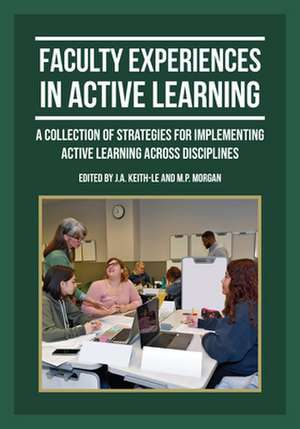Faculty Experiences in Active Learning
Editat de J. A. Keith-Le, M. P. Morganen Limba Engleză Paperback – 15 mai 2020
Preț: 168.24 lei
Nou
Puncte Express: 252
Preț estimativ în valută:
32.19€ • 33.70$ • 26.64£
32.19€ • 33.70$ • 26.64£
Carte tipărită la comandă
Livrare economică 07-21 aprilie
Preluare comenzi: 021 569.72.76
Specificații
ISBN-13: 9781469660035
ISBN-10: 1469660032
Pagini: 170
Dimensiuni: 178 x 254 x 11 mm
Greutate: 0.49 kg
Editura: UNC Charlotte J. Murrey Atkins Library
ISBN-10: 1469660032
Pagini: 170
Dimensiuni: 178 x 254 x 11 mm
Greutate: 0.49 kg
Editura: UNC Charlotte J. Murrey Atkins Library
Notă biografică
J.A. Keith-Le, MFA, is an instructional design and academic technology professional with the UNC Charlotte Center for Teaching and Learning. She has over twenty years of experience in education and the arts, both in the public and private sector. She facilitates the faculty learning community on campus for active learning. She was awarded the Steelcase Education Active Learning Center Grant in 2019 to build active learning classrooms and research student engagement at UNC Charlotte. Her other research interests include non-traditional higher education populations, gendered negotiation, and faculty development.
M.P. Morgan, PhD, has been a member of the UNC Charlotte faculty since fall 1987, worked in the Department of English, and retired in 2016. While there, she received three teaching awards, administered several academic programs, taught a range of writing classes, worked for education at local, state, and national levels, and wrote or edited several books. Teaching has been her passion for almost fifty years, and she continues to teach one course a year in English and to work for the UNC Charlotte Center for Teaching and Learning.
M.P. Morgan, PhD, has been a member of the UNC Charlotte faculty since fall 1987, worked in the Department of English, and retired in 2016. While there, she received three teaching awards, administered several academic programs, taught a range of writing classes, worked for education at local, state, and national levels, and wrote or edited several books. Teaching has been her passion for almost fifty years, and she continues to teach one course a year in English and to work for the UNC Charlotte Center for Teaching and Learning.
Descriere
Authored by Active Learning Academy members, this book is for higher education faculty and students planning to teach at the post-secondary level and is a guide for considering the diverse pathways that active learning can take based on student population, approach, discipline, and learning environment.
